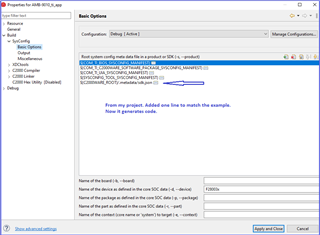Other Parts Discussed in Thread: SYSCONFIG, C2000WARE
I am using the TI Sytem Configuration Tool to set up the pin mux assignments. I created a .syscfg file and dropped it into my project directory. CCS prompted me to add it to the project and make necessary adjustments. When I compile, I do not get any generated code. I have looked at the training material but I found no mention of what to do if the code is not generated.
Here is an excerpt form the build window:
Building file: "../ti_sys_config_tool_file.syscfg"
Invoking: SysConfig
"C:/ti/ccs1120/ccs/utils/sysconfig_1.12.0/sysconfig_cli.bat" --script "C:/PRODEV/Prj_1/Prj_1_app/ti_sys_config_tool_file.syscfg" -o "syscfg" --compiler ccs
Running script...
Validating...
Generating Code (ti_sys_config_tool_file.syscfg)...
Writing C:\PROJECTS\Prj_1\Prj_1_app\Debug\syscfg\PinmuxConfigSummary.csv...
Finished building: "../ti_sys_config_tool_file.syscfg"
See attached images....
1) From my project
2) From: https://software-dl.ti.com/C2000/docs/software_guide/c2000_sysconfig.html

































